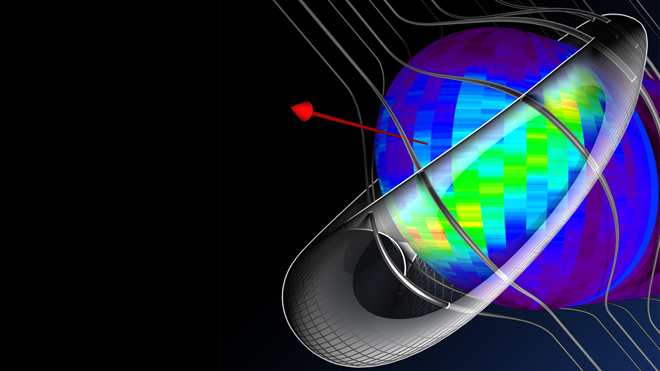It looks like you're using an Ad Blocker.
Please white-list or disable AboveTopSecret.com in your ad-blocking tool.
Thank you.
Some features of ATS will be disabled while you continue to use an ad-blocker.
22
share:

A NASA spacecraft was the first to spot a strange ribbon of energy and particles at the edge of the solar system. Scientists have said that it appears to be a 'roadmap in the sky' for the interstellar magnetic field.
NASA's Interstellar Boundary Explorer (IBEX) discovered the solar system's mysterious energy ribbon in 2009. Scientists are observing the mysterious energy ribbon to gain a better insight into how the sun's environment protects that solar system from high-energy cosmic rays.
"What I always have been trying to do was to establish a clear connection between the very high-energy cosmic rays we're seeing (from the ground) and what IBEX is seeing", study leader Nathan Schwadron, a physicist at the University of New Hampshire, told Space.com.
Scientists believe that a better understanding of this energy ribbon could help them find details about the boundary between our solar system and interstellar space.
Prior to IBEX, NASA's Voyager 1 spacecraft provided the only source of information to find answers from the boundary in question. The spacecraft is now trying to find the outer extent of the Sun's magnetic field and solar wind, called heliopause.
Well, Well, Well...
Here we go. It seems our species are making remarkable new discoveries almost daily now. I think in the past two years I've personally noted over a dozen great finds, discoveries and developments regarding the Micro and Macro. Here we have a short but interesting read.
As Always, Stay tuned
Weld love to read more info on the new tech used to gauge this compared to voyager1. Very interesting find 😉
reply to post by SLAYER69
Another great thread Slayer.
But is the field there to protect the solar system.
Or to protect us?
Another great thread Slayer.
But is the field there to protect the solar system.
Or to protect us?
reply to post by dusty1
I'm not exactly sure but for some reason this thread came to mind...
 Astronomers Capture The First Image Of The Mysterious Web That
Connects All Galaxies
Astronomers Capture The First Image Of The Mysterious Web That
Connects All Galaxies
I'm not exactly sure but for some reason this thread came to mind...

For the first time, astronomers were able to see a string of hot gas known as a filament that is thought to be part of the mysterious underlying structure that dictates the layout of all the stars and galaxies in our universe.
It is what we do with this knowledge that makes it great or terrible. I hope with newer and profound discoveries that there would be a certain
responsibility applied to its applications in regards to how we as people choose to further manipulate and probe these things and forces we do not
understand fully yet.
Seems to me that this could be important in future breakthroughs in space travel.
Good find, Slayer.
Good find, Slayer.
reply to post by Brotherman
Isnt that always the case?
This is why we can't seem to have nice things
Isnt that always the case?
This is why we can't seem to have nice things
The magnetic field is just there as a consequence of the Sun's magnetic field. It's purpose is not to protect anything. What it does do however is
reduce the number of cosmic rays at lower energy from penetrating so deep into the solar system. If you look at the flux plot for reconstructed
primary cosmic rays there is a knee and ankle structure. This is what is being investigated.
new topics
-
Simulation theory and have we reset before like a game?
Conspiracies in Religions: 4 hours ago -
Imagine how it feels
US Political Madness: 6 hours ago -
Do I post here or Cryptozoology.
Ancient & Lost Civilizations: 7 hours ago -
Breakthrough treatment flips cancer cells back into normal cells
General Chit Chat: 7 hours ago -
New World Order Coming?
New World Order: 8 hours ago
top topics
-
Breakthrough treatment flips cancer cells back into normal cells
General Chit Chat: 7 hours ago, 9 flags -
Imagine how it feels
US Political Madness: 6 hours ago, 8 flags -
Short vs. Long?
General Chit Chat: 16 hours ago, 5 flags -
New World Order Coming?
New World Order: 8 hours ago, 5 flags -
Do I post here or Cryptozoology.
Ancient & Lost Civilizations: 7 hours ago, 5 flags -
Simulation theory and have we reset before like a game?
Conspiracies in Religions: 4 hours ago, 4 flags
active topics
-
Get Reday - Here comes the Bird Flu Pandemic - Millions are Notified
Diseases and Pandemics • 44 • : nugget1 -
New World Order Coming?
New World Order • 22 • : StoutBroux -
Simulation theory and have we reset before like a game?
Conspiracies in Religions • 8 • : BeyondKnowledge3 -
Kurakhove officially falls. Russia takes control of major logistics hub city in the southeast.
World War Three • 35 • : nugget1 -
Outgoing Lame Duck BIDEN Officials and Democrats Voice Their Regrets.
2024 Elections • 23 • : nugget1 -
Reflections of Elections past
US Political Madness • 5 • : lilzazz -
Why Such An Uproar Over Non-US Citizens With H1-B Work Visas.
Social Issues and Civil Unrest • 122 • : Daughter2v2 -
Mood Music Part VI
Music • 3771 • : lilzazz -
Treasury Secretary Janet Yellen Says The USA Will Be in Debt Default in Jan 2025 - Unless...
Mainstream News • 41 • : Astrocometus -
Post A Funny (T&C Friendly) Pic Part IV: The LOL awakens!
General Chit Chat • 7971 • : Cymru
22
